FRUIT TREE PRUNING
In 1985, when Chuck started his tree career, his old mentor always mentioned that “a properly pruned fruit tree almost looks like it has been hit by a helicopter”. As much as this advice seemed odd, it became clear when Chuck worked his first apple orchard.
As an ISA Certified Arborist, Chuck has made an oath never to ‘top’ a tree. Not because it is an improper pruning practice, but because a fruit tree, properly pruned, has the appearance of being ‘topped’. The proper pruning technique allows a majority of the non-fruit-producing branches to be removed from the tree while opening up the canopy. This allows full sunlight and can shine on all of the remaining fruit-bearing branches. It looks brutal, but it is a necessary and productive practice.

This old apple tree shows the neglect of pruning. The excessive sucker sprouts in the middle of the tree make it a very non-productive fruit-producing tree.

After the pruning, notice the excessive growth was removed and the interior portions of the canopy will now be able to get much-needed sunlight. This tree will be able to produce quality fruit.

Another overgrown Apple tree with lots of sucker growth. If fruit is produced on the tips of the limbs, it will bend over and break with the weight of the fruit. This reduces the length and amount of limbs will allow for good fruit to be produced on sturdy branches.

After we pruned this back, notice there are fewer, more stout branches. This tree is ready to support the growth of the fruit.

This old Apricot tree hadn't been pruned for years. UTC thinned the canopy allowing for more sun within the interior branches. This reduced the canopy for better fruit production

The finished product after pruning. This tree is ready to put on some healthy apricots!
